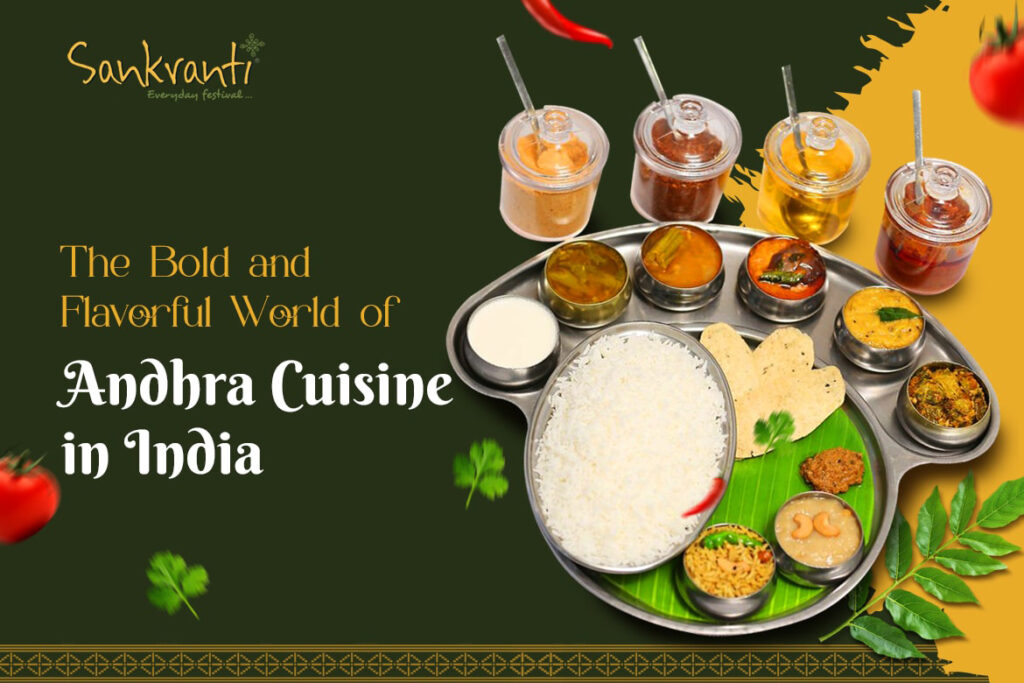Andhra cuisine is a vibrant celebration of bold flavors, rich spices, and unique cooking techniques. Known for its fiery heat and tantalizing aroma, Andhra cuisine is a must-try for food lovers in India. Whether you crave a plate of aromatic Dum Biryani or a comforting bowl of Pappu Dal, Andhra cuisine offers a delicious and unforgettable experience.
The Essence of Andhra Cuisine
Andhra cuisine is deeply rooted in tradition, using a variety of spices, tamarind, and lentils to create dishes that are both flavorful and satisfying. Some of the most iconic dishes include:
- Gongura Pachadi: A tangy and spicy chutney made from sorrel leaves, offering a perfect balance of flavors.
- Andhra Dum Biryani: A fragrant and spicy rice dish layered with marinated meat and cooked to perfection.
- Mirchi Bajji: Deep-fried green chili fritters stuffed with tangy fillings, ideal for spice lovers.
- Kodi Vepudu: A dry and spicy chicken fry that pairs wonderfully with steamed rice.
What Makes Andhra Cuisine Unique?
The distinguishing factor of Andhra cuisine lies in its liberal use of chilies, tamarind, and aromatic spices. Gongura (sorrel leaves), tamarind-based gravies, and fiery pickles add depth and intensity to the flavors. The cuisine is also known for its extensive use of lentils and vegetables, making it a well-balanced diet.
Where to Find Authentic Andhra Cuisine in India
For those looking to experience the best Andhra Cuisine India has to offer, Sankranti is the perfect destination. Our menu features a carefully curated selection of Andhra’s most beloved dishes, prepared using authentic spices and age-old techniques. From traditional Andhra thalis to flavorful biryanis, every dish is a tribute to the culinary heritage of Andhra Pradesh.
The Andhra Experience at Sankranti
At Sankranti, we bring the essence of Andhra cuisine to India with dishes that capture the true spirit of the region. Whether you’re indulging in our spicy curries, relishing the tang of our pickles, or savoring the richness of our biryanis, each bite is a journey through Andhra’s bold and flavorful world.
Experience the magic of Andhra Cuisine India at Sankranti and treat yourself to an explosion of taste and tradition.
faqs
What is Andhra style cooking?
Andhra style cooking is characterized by its bold use of spices, tamarind, and chilies, resulting in rich and flavorful dishes. The cuisine features a variety of rice-based meals, tangy chutneys, and spicy curries.
Why are Andhra meals famous?
Andhra meals are famous for their spicy and tangy flavors, generous use of aromatic spices, and well-balanced combinations of rice, curries, and side dishes. The traditional thali, which includes multiple dishes, offers a wholesome and satisfying experience.
Is Andhra food spicy?
Yes, Andhra food is known for its high spice levels, often incorporating a variety of chilies to enhance flavor and heat. However, the spice level can be adjusted to suit different preferences.
How to eat Andhra meals?
Andhra meals are traditionally served on a banana leaf and eaten with hands to fully experience the textures and flavors. The meal typically starts with rice, dal, and ghee, followed by curries, pickles, and curd to balance the spice.
What is the spiciest dish in India?
Phaal Curry, originally developed in British Indian restaurants, is considered one of the spiciest Indian dishes. Among traditional Indian dishes, Andhra’s Natu Kodi Pulusu (spicy country chicken curry) is known for its intense heat.
Which state in India eats the spiciest food?
Andhra Pradesh is widely regarded as the state that consumes the spiciest food in India, with its cuisine heavily relying on red and green chilies.
What is the spiciest cuisine in the world?
Sichuan cuisine from China, known for its liberal use of Sichuan peppercorns and fiery chili peppers, is often considered the spiciest cuisine in the world. Thai, Indian, and Mexican cuisines also feature prominently for their heat levels.
What is a traditional diet?
A traditional diet consists of whole, natural foods that have been consumed for generations within a specific culture. It typically includes fresh vegetables, whole grains, legumes, and minimally processed ingredients, emphasizing balance and nutrition.








